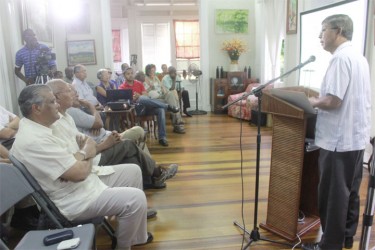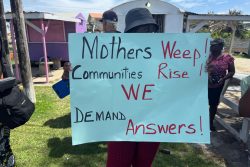Businessman Stanley Ming believes the next big flood to hit the country could be much worse than experienced in 2005 and laments the state of some of the sea defence infrastructure that he has seen over the past years and the nature of the repair works on them.
He was delivering a lecture yesterday at Moray House Trust entitled ‘A Strategic Overview of Integrated Transportation Routes, Sea Defences and Related Land Use’.

Ming said that following visits to various parts of the East Coast sea wall, the state of the sea defence leaves him with little confidence that the work done over the years would keep the sea out and said this is why he is moving to Parika, East Bank Essequibo to live. He had on display pictures he took of a crumbling sea wall in 2001 and the efforts to repair them which were in his estimation poor.
“I am afraid that the next big flood will make 2005 look like a walk in the park,” he said, noting that the state of sea defence and infrastructures such as kokers leaves him with little choice but to move.
He also lamented the penchant of the authorities for bringing small pumps to take the place of non-functional larger pumps, which he said are also insufficient to drain as much as sluices are designed to. He said that in some places, where there is a network of seven kokers all meant to work together, five of them are non-functional, leading to further risk of flooding in the event of high tides.
While he applauded efforts at replanting mangrove trees, he does not believe that mangroves are meant to keep the water from overtopping the sea defences. He said that they do prevent erosion.
Ming stated that having been affected by the 2005 flood, he promised his family that they will not go through such an experience again.
During the presentation, Ming spoke of a number of infrastructure studies looking at roads and bridges in Guyana with a view to stirring the interest of the authorities to address the increasing congestion created by new housing areas along the East Bank and West Bank.
Ming spoke of studies and plans that have been done since the 1960s and 1970s onwards and on which there has been no implementation or no consideration in current planning.
His presentation took the form of a Powerpoint, during which he shared documentation, aerial photographs and maps detailing where roads were planned to be positioned with a view to easing congestion around certain carriageways.
Ming said that it makes sense to construct alternative roads not only on the East Bank but also on the West Bank and to have more than one bridge across the Demerara River since the growth of housing areas along the East and West Banks will in a few years justify these investments. He said that in five to ten years the number of residents in those housing areas along the East and West Banks will significantly increase since many of the plots in these areas allocated for housing development have not yet been occupied and developed.
He spoke of a road continuing from Sheriff Street and Mandela Avenue and linking with a parallel East Bank road which he said would ease traffic woes on the East Bank.
Ming suggested that various models of financing, including Public Private Partnerships (P3) could be employed to get such projects off the ground and noted that what he referred to as high levels of deposits in local banks could be tapped into. He said that persons in the interest of developing their country may want to contribute to a development fund which would offer a good return on their investment and this money could go towards infrastructure projects.
He spoke of models in India where the new road passes are financed by persons investing in a fund for its construction. He said that persons will value the investments more once they have a stake in it. During the question and answer segment, one participant pointed out that there seems to be a lack of political will to implement the plans. Another person said that the people with the skills and the expertise are usually shut out of the decision making process informing of the projects.
Adrianus Vlugman, an official of PAHO/WHO said that the P3 is an excellent opportunity to make investments in infrastructure and open up avenues beyond the capacity of the Government. “As Ming said there is a lot of money in private hands that people want to invest.
They could get 10 percent guaranteed interest in five years and I am looking forward to these opportunities in the future,” he said.









